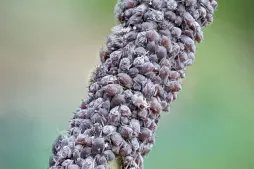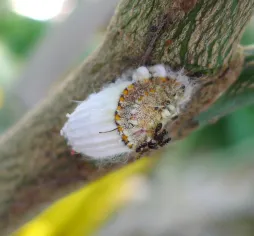Sansevieria trifasciata 'Futura Simplex', a stepmother's tongue with marbled leaves
Decorative and easy to care for, the Sansevieria trifasciata species has given rise to numerous cultivars. Among them, Sansevieria trifasciata 'Futura Simplex'. With its upright habit and multicolored leaves, this houseplant combines the qualities of Sansevieria trifasciata 'Laurentii' with those of Sansevieria trifasciata 'Golden Hahnii'.
How to recognize Sansevieria trifasciata 'Futura Simplex'?
This variety of stepmother's tongue has an intermediate habit: it is both upright and open. It can reach a height of 80 centimetres.
As with other sanseviers, its leaves are spear-shaped with a sharp tip. They can be up to ten centimetres wide. They are green, mottled with a darker shade of gray and edged with yellow.
In optimal conditions, the succulent plant flowers in spring. The white or pink flowers grow on an upright spike. What makes them special? They release their delicate fragrance only at night. They are then replaced by small orange fruits.
Although Sansevieria trifasciata 'Futura Simplex' is said to have depolluting properties, it is toxic to pets and humans. When ingested, it causes gastric disorders.
Our maintenance tips
To grow sansevieria trifasciata 'Futura Simplex indoors, reproduce the conditions of their natural environment! Sun, warmth and little water. You can even take your succulent out to your windowsill or garden in summer.
Watering
Sansevieria trifasciata 'Futura Simplex come from arid regions. These plants are drought tolerant, but still require watering.
Water only when the substrate is dry, using rainwater at room temperature. If you don't have any, you can use mains water that has been left to stand for 24 hours.
To replenish its reserves, your Sansevieria trifasciata 'Futura Simplex needs copious watering. Water the soil until it is completely moist and the water runs off through the pot's drainage holes.
Drain any stagnant water from the cup or planter. It may rot the roots.
Spray
Sansevieria trifasciata 'Futura Simplex grow in arid regions and do not like humidity. No need to spray them.
Repotting
In spring, transfer your Sansevieria trifasciata 'Futura Simplex' to a larger pot, so that it can continue to grow.
Take advantage of repotting to offer your plant a pot in which its roots will flourish and moisture will not settle.
Choose a terracotta pot with holes. Pour a bed of gravel or, better still, pieces of pozzolan into the bottom. Then add a draining potting soil such as a special substrate for cacti and succulents, or a mixture of garden soil and sand. For even more nutrients, top up with leaf compost if available.
After removing your specimen, carefully untangle its roots and install it in its new location. Cover with potting soil and tamp down. Finish with a thin layer of clay balls or pozzolan on the surface to facilitate drainage.
To avoid the risk of stagnant water, avoid saucers and planters. If you use a planter, line the bottom with gravel or clay pebbles.
Fertilization
You can stimulate the development of your plant during its growth phase, in spring and summer, with fertilizer.
If you want to stimulate the growth of your Sansevieria trifasciata 'Futura Simplex', mix a liquid fertilizer for cacti and succulents with the water when watering.
Prune
Remove dry leaves and cut the flowering stem at the base after flowering.
However, it is not advisable to prune your Sansevieria trifasciata 'Futura Simplex. A cut leaf will not grow back, even if you only trim the tip.
However, it is not advisable to prune your Sansevieria trifasciata 'Futura Simplex. A cut leaf will not grow back, even if you only trim the tip.
Plantation
Once the last spring frosts have passed, you can plant.
Where's the best place to plant your Sansevieria trifasciata 'Futura Simplex? A sunny spot at the top of a slope, to encourage rainwater drainage.
Dig a large hole to give the roots room to spread out. As for repotting, place a layer of gravel at the bottom, followed by a layer of substrate. Place your plant in the center and cover with soil, possibly enriched with leaf compost. Press down to eliminate air pockets and water.
Cutting
Cutting is carried out during the strong growth phase, generally in spring and early summer.
After a few years, young shoots appear at the base. With a sharp knife, dig up one of these "babies", also removing its roots.
Prepare a pierced terracotta pot. Block the hole with a pebble and lay a bed of gravel. Pour in a substrate composed of one third potting soil, one third soil and one third sand to promote drainage. Plant your offshoot, tamp it down and add a layer of sand to the surface.
Place your new succulent in a bright room, but without direct sunlight and with a temperature of at least 18 degrees.
Between two applications of water, check that the substrate has dried out, as you would with a mature plant.
Diseases / Threats
Information
| Family | Asparagaceae - Asparagaceae |
| Type | Sansevieria - Sansevieria |
| Species | Mother-in-law's language - Sansevieria trifasciata |
| Lifecycle | Perennial |
| Foliage | Evergreen |
| Exposures | |
| Substrats | |
| Planting methods |
In pots In tubs Planter |
| Categories | |
| Tags |
Beginner Toxic |
| Origins |
East Africa Central Africa |
| Hardiness (USDA) | 11a |
| Leaf color |
|
| Flower colors |
|
| Fruit color |
|
Discover plants from the same family
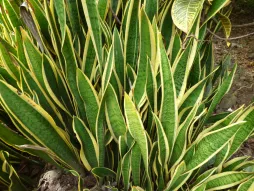
Mother-in-law's language
Discover
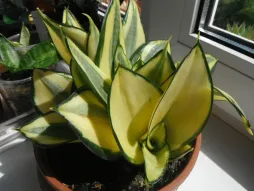
Sansevieria trifasciata 'Golden Hahnii' (Golden Hahnii)
Discover
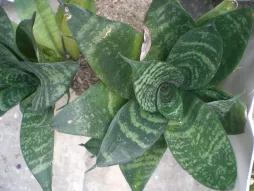
Sansevieria trifasciata 'Hahnii Green Leaves
Discover
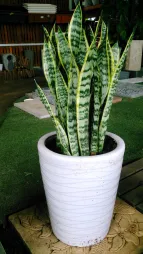
Sansevieria trifasciata 'Laurentii
Discover











